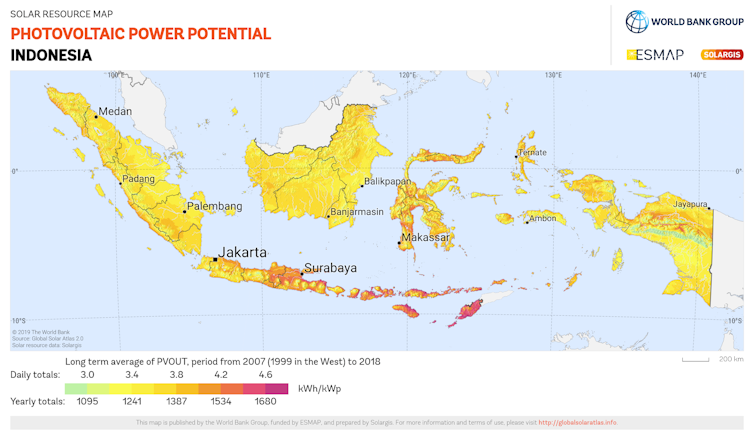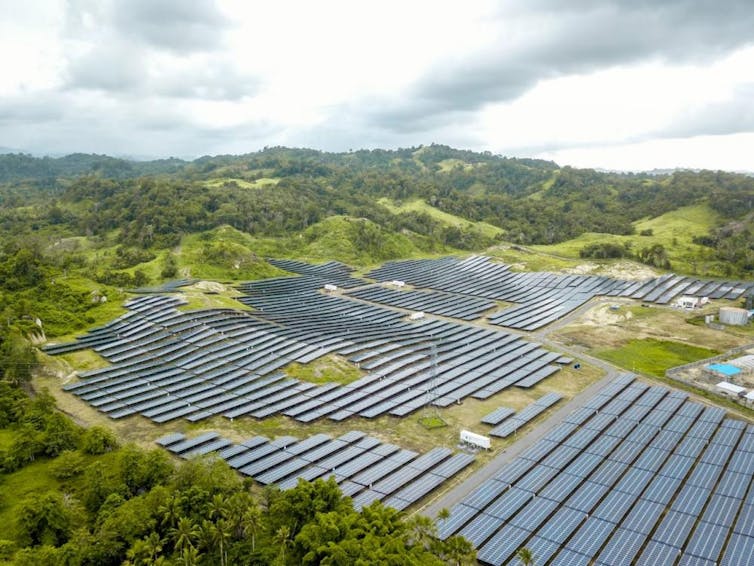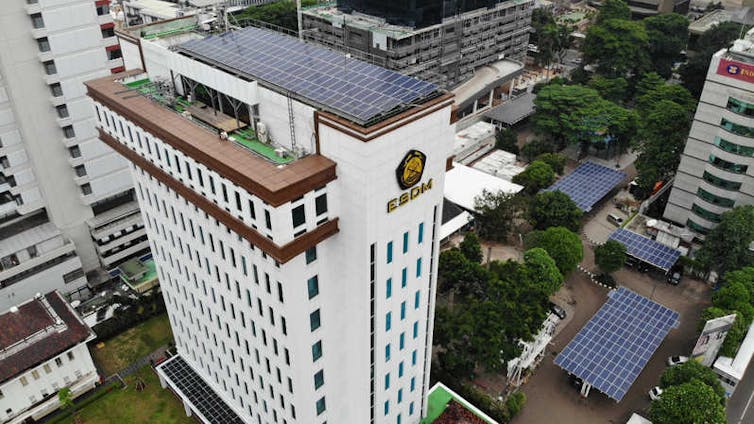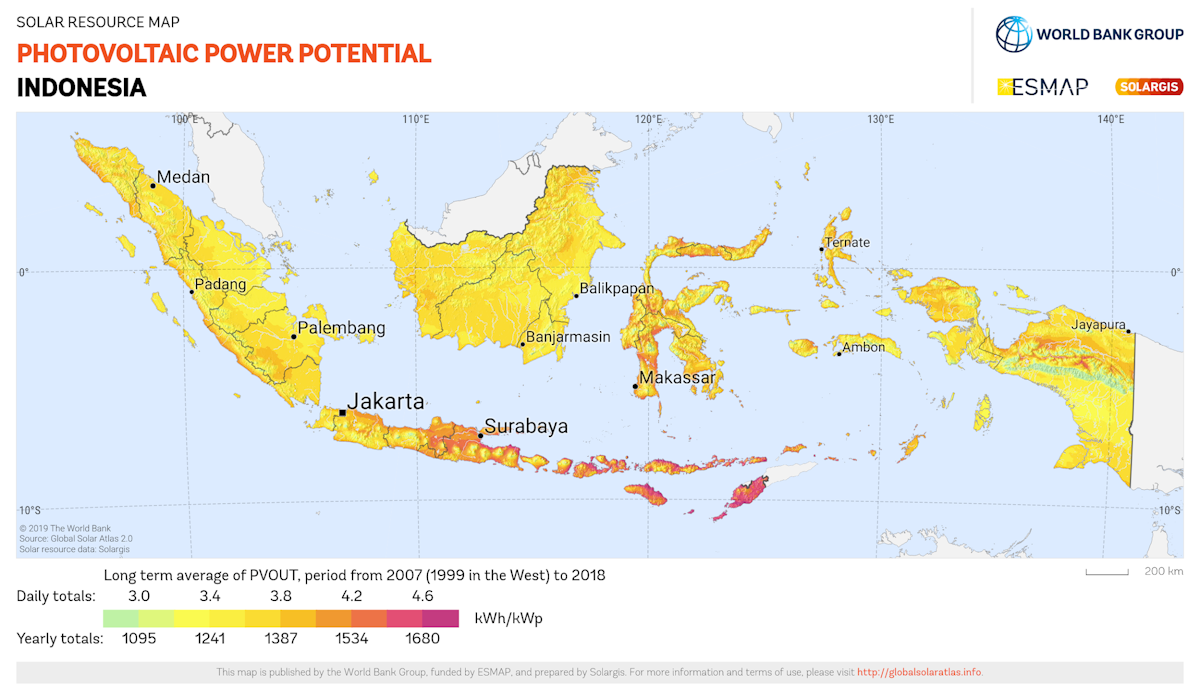This article by David Firnando Silalahi appeared in The Conversation today.
David Firnando Silalahi, Australian National University
This article is part of a series to celebrate Earth Day on April 22.
Indonesia is a tropical country with year-round sunshine. My research on how Indonesia can generate electricity entirely from renewable energy has calculated the country has the potential to generate about 640,000 Terrawatt-hours (TWh) per year from solar energy. That’s equivalent to 2,300 times last year’s electricity production.
Despite this huge energy potential, investment in the renewable energy sector is still low. Hence, solar energy contributed only 1.7% to the country’s total electricity production last year.
Southeast Asia’s largest economy produced 275 TWh of electricity from various power plants with a total capacity of 69.1 gigawatt (GW) last year. Coal, gas and diesel power plants supplied almost 90% of electricity. The rest comes from power plants using renewable energy – hydro, wind, geothermal, solar and biofuel.
The domination of non-renewable energy power is expected to last until 2050.
Even though Indonesia has abundant solar energy, state power firm PLN, currently the only electricity supplier, can’t tap into it right away as it is bound by contracts it has signed with various power plant operators. These contracts last for a minimum of 20 years.
The government predicts the use of solar energy in electricity production will only account for less than 10% of the total energy mix by 2050.
I argue that, with its abundant sunshine and unique topography, Indonesia should be able to generate 100% green electricity from its solar energy by 2050. The government needs to set attractive policies for both customers and power providers to make this happen.
Here are three reasons why Indonesia has the potential to generate its electricity entirely from solar energy:
1. More than enough sunlight#
Indonesia’s electricity consumption was 1 megawatt-hours (MWh) per capita in 2019, only 11% of Singaporean consumption.
Indonesia’s National Electricity General Plan states that the country’s electricity demand will reach 1,000 TWh, equal to 3.3 MWh per capita, in 2038.
Assuming this trend continues, the projected electricity demand will reach 2,600 TWh, or 7.7 MWh per capita, by 2050.

To supply the 2050 demand, Indonesia needs a total capacity of 1,500 gigawatt (GW) of solar photovoltaic (PV) power plants. Solar PV works to convert sunshine to electricity using photovoltaic modules. It is expected 230 MW solar PV will be installed this year.
According to my research, providing 2,600 TWh electricity will not be an issue due to the massive solar energy that Indonesia has.
2. Have large areas to install PVs#
To install enough PVs to meet the 2050 target, Indonesia needs at least 8,000 square kilometres, or about 0.4% of the country’s land area,.

Should problems with land acquisitions arise, the government could also install the solar panels on water. A large fraction of these panels can be placed on floats on lakes and sheltered seas.
Indonesia has huge water territory as the world’s largest archipelago. It has lakes with an area of about 119,000km² and territorial sea of about 290,000km².
Additionally, most buildings can host solar panels on the roof. With these plans, the installation of solar panels will require only 0.1% of Indonesia’s land.

3. Decreasing costs to set up solar PV farms#
The global weighted-average cost of investment in large-scale solar PV is falling fast. It fell by 77% between 2010 and 2018.
In Australia, the cost of large-scale solar projects has fallen dramatically from US$85/MWh in 2015 to an expected US$28-39/MWh in 2020.
These prices are well below the cost that Indonesia’s state power firm, PLN, needs to generate electricity, at around US$79/MWh.
To meet the 2050 figure, the government must generate 50 GW from solar energy each year, starting 2021, and connect it to power grids.
This is likely achievable, considering that building solar PV projects is much faster than for fossil power plants.
A solar PV farm needs a maximum of two years of construction, while coal-fired power plants need at least three years to complete.
To supply electricity at night, the PV system will need battery storage. Battery prices have also fallen by 87% since 2010, to $156/kWh in 2019. Prices are expected to continue to decrease to $61/kWh by 2030.
Complementing batteries, pumped hydro energy storage is also able to store electricity during sunny days and quickly distribute it when electricity generation is interrupted during cloudy weather.
Indonesia has 26,000 good pumped hydro sites with a combined storage capacity of 820 TWh. This number is 100 times more than required to support a 100% renewable electricity system from solar panels in Indonesia.
The need to go green#
Indonesia has pledged to reduce greenhouse gas emissions by 29-41% by 2030.
It has also set an ambitious target that its renewable energy portion will double to 23% of the country’s total energy mix to generate electricity by 2025. It is expected to reach 31% by 2030.
However, last year, Climate Action Tracker (CAT), an independent research organisation tracking climate action, reported that Indonesia has failed to reduce carbon emissions. CAT concluded that no concrete measures are being taken, and rated Indonesia as “highly insufficient action”.
Fossil fuel power plants and transportation still contributed 34% of Indonesia’s emissions in 2017. This could become much larger as energy consumption increases unless Indonesia shifts electricity generation to renewables as other countries do.
For example, Australia reached a 25% renewable energy target in 2019 and is on track to reach 50% renewable energy in 2025 by installing wind power and PV. Vietnam has secured 135 solar PV projects with a total capacity of 9 GW.
India has installed 32 GW of solar PV, with a target of 100 GW by 2022. Singapore is constructing a 60 MW floating solar PV plant.
The vast and consistent abundance of sunshine in Indonesia, in combination with the low and falling price of solar PV, means 100% renewable electricity with zero emissions is eminently feasible for Indonesia to achieve in 2050.
If you could enjoy environmentally friendly electricity without worrying about the bill, wouldn’t you be happy?![]()
David Firnando Silalahi, Phd Candidate, Research School of Electrical, Energy and Materials Engineering, Australian National University
This article is republished from The Conversation under a Creative Commons license. Read the original article.
